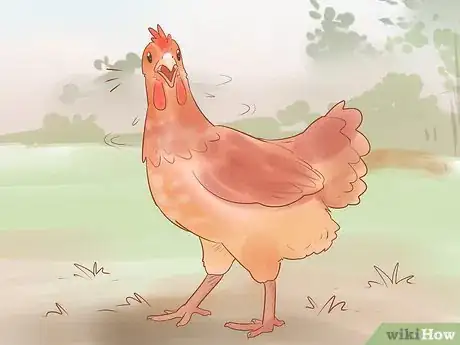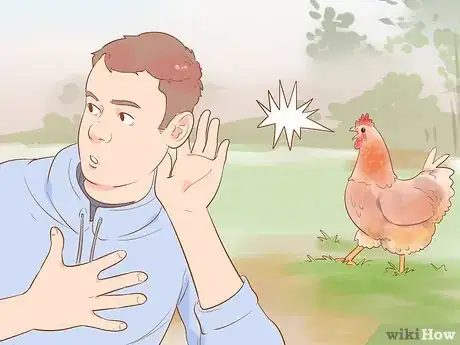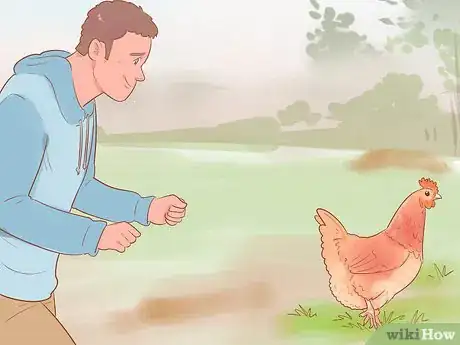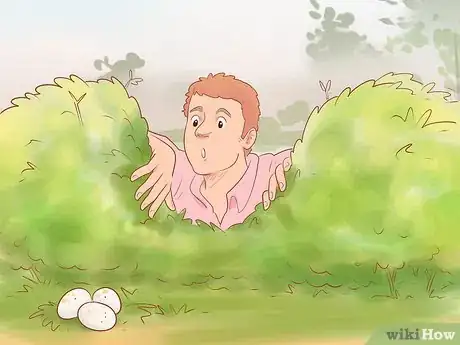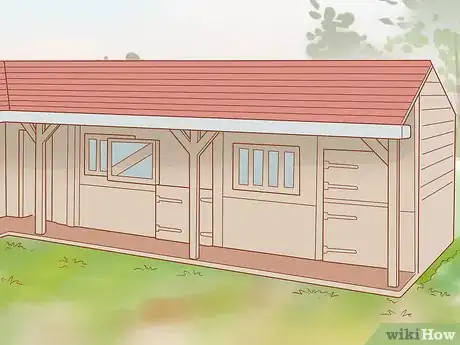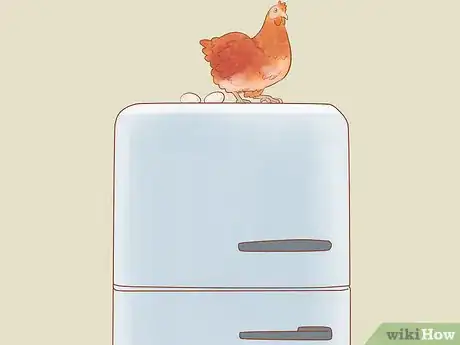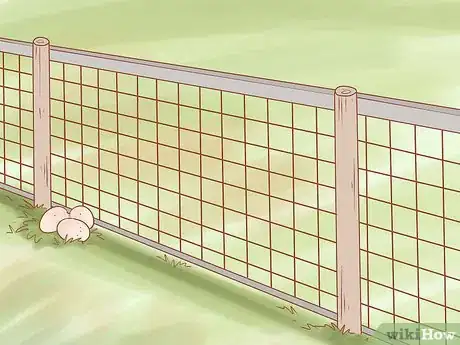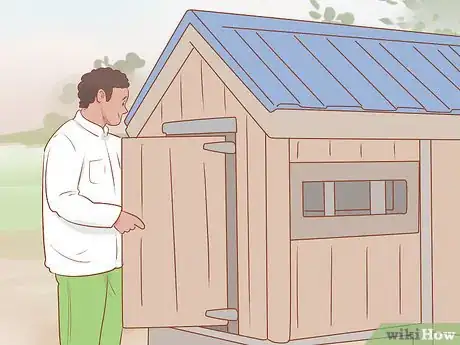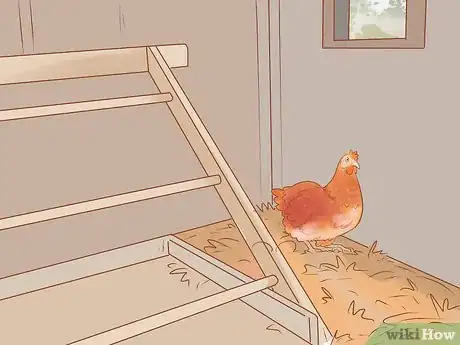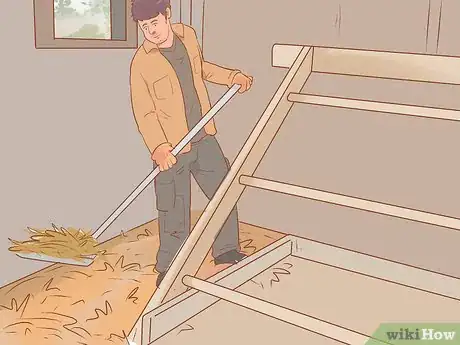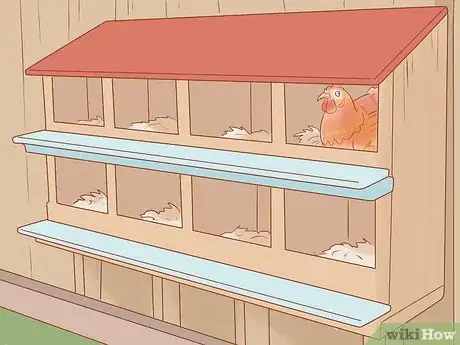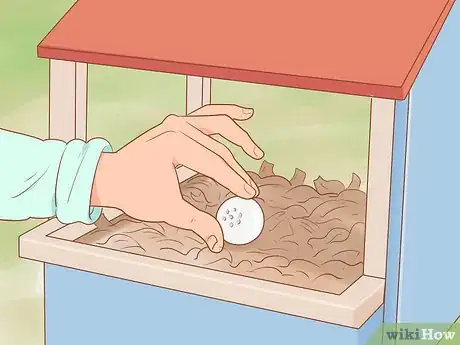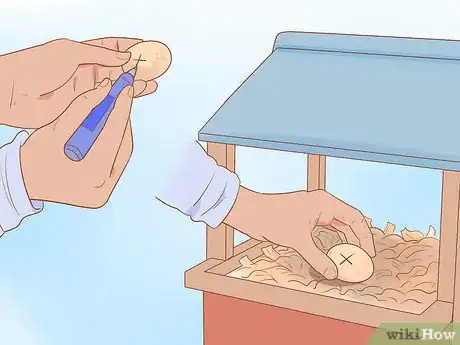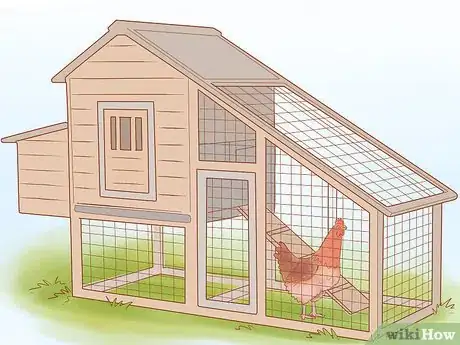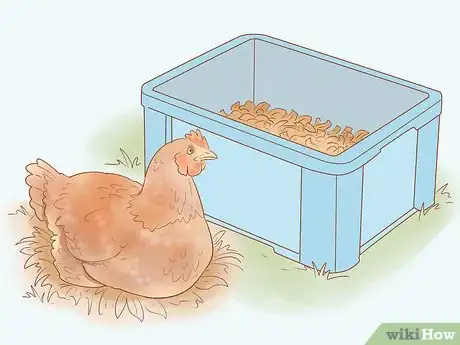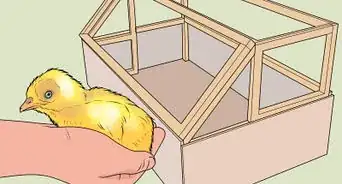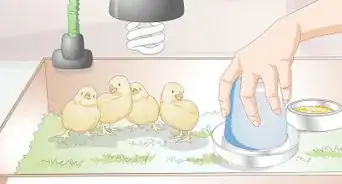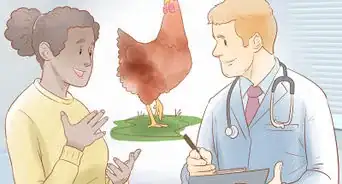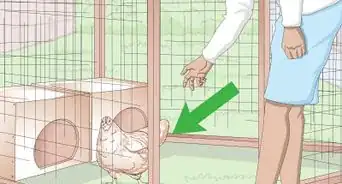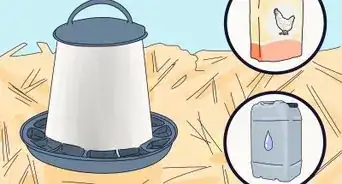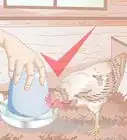This article was co-authored by wikiHow Staff. Our trained team of editors and researchers validate articles for accuracy and comprehensiveness. wikiHow's Content Management Team carefully monitors the work from our editorial staff to ensure that each article is backed by trusted research and meets our high quality standards.
There are 8 references cited in this article, which can be found at the bottom of the page.
This article has been viewed 93,092 times.
Learn more...
Chickens are notorious for running off to lay their eggs in hidden spots. Of course, if you're collecting a chicken's eggs, you don't want to go on a hunt every day to find them! You can try following your chickens to see where their nests are or simply search high and low for the nests. Whether you find the nests or not, you can take steps to encourage your hen to lay in the nests you provide in the coop.
Steps
Following Your Hens
-
1Get up early in the morning to watch your hens. Hens most often lay early in the morning, so if you're going to catch one the act, you'll need to beat it to the punch. Try getting up before sunrise to observe your hens' behavior.
- Keep in mind, some hens will lay in the afternoon, too, so you may need to observe your hens throughout the day.[1]
-
2Watch for restlessness and other egg-laying behavior. Hens tend to get restless when they're about to lay an egg. They'll start actively looking around for a nest at this point, as they feel the egg coming on. Watch your hens for this behavior.[2]
- Your hens may seem extra cranky, too.
Advertisement -
3Listen for loud cackling. Often, a hen will let off a loud cackle when she's laid an egg. You may be able to follow the sound of the cackling to find the egg or eggs she's laid away from the main nesting box.[3]
- Hens will often start cackling early in the morning to indicate they're laying eggs.
-
4Keep an eye on where your hens go. Watch any hens that leave the coop and nesting area. Observe where they go so you can search for their nests later. Try following at a distance so as not to alarm your hen.
- While it's time-consuming to keep an eye on your chickens, it's one of the sure-fire ways to find a nest.
Thinking Like a Chicken
-
1Look under bushes and logs. Chickens like a secure nesting area, and often, areas underneath things like bushes can look appealing. Get down on a chicken's level and look around. You may find some eggs!
- You may also find them at the base of trees or nestled down in the grass.
-
2Check in warm, semi-indoor areas. If you have places in your yard like a barn or a shed that have openings for your hens to get in, check in there for eggs. Your hen may decide a hayloft or a manger is a great place to lay, especially since it's out of the elements![4]
- Make sure to look in all the hidden holes you can find in these buildings!
-
3Search high and low in places you might not expect. Hens aren't particularly rational about where they lay their eggs. While they typically pick a shaded area for protection, yours might decide to lay on top of a freezer or in a tractor seat. It really depends on the chicken! So make sure to search the area from all angles, as you never know where you'll find eggs.
- Some may even lay eggs in the middle of the yard.
- If you have kids, get them to help you look! They can spot things down low you might not see.
-
4Walk along the fence line. Chickens often like to lay eggs next to a barrier or in a corner, so check your fence line for hidden nests. You may find one in a far back corner, for instance.
- The same is true around your house. Walk around the outside of your house to see if your chickens have laid eggs around the border.
-
5Make sure the eggs aren't in the coop. Have a good look inside your chicken coop, including the run and under the housing, as your chickens may have laid their eggs in the coop but not in the nesting area. You may find them in corners, in the roosting area, or even in the middle of the floor.
Encouraging a Hen to Use the Nest
-
1Position your nests in a lower area than your roosting area. Hens need separate areas for roosting and nesting. If they roost in an area, they may not lay there. Since they prefer higher areas for roosting, make sure that the nests are lower to the ground.[5]
- However, try not to put nests directly below roosting areas, as you'll end up with feces all over your eggs.
-
2Clean the nesting area out at least once a week. It may be tempting to just to add more pine shavings to the top of the nest. However, it's best to sweep out all of the litter and scrub down the nesting area if it has a layer of feces. Then, add fresh litter back to the area. A clean nest will encourage your chickens to use it.[6]
- Try using dish soap and warm water if you need to scrub down the coop.
-
3Ensure you have enough nests for your hens. You don't need 1 nest per hen, as hens will use the same nest. Make sure to have at least 1 nesting spot for every 4 hens or so and at least 2 if you just have 5 or 6 hens.[7]
- Nesting spots are the individual cubbyholes where chickens lay their eggs.
-
4Use pine shavings instead of hay for nesting material. You need nesting material to encourage your chickens to lay there. However, hay can harbor bacteria and parasites, and it is more likely to stay damp. Instead, use pine shavings, which is equally cheap but more hygienic overall.[8]
- You can find pine shavings at most tractor supply stores.
-
5Place golf balls or fake eggs in the nest. Most hens will lay in places where there are already eggs. You can fake out a chicken by using egg replacements. When the chicken sees these fake eggs, she'll lay in the nest, too.[9]
- Try wooden eggs, for instance.
-
6Move real eggs to the nest. If you find eggs outside the nest, you can just pick them up and put them in the nest. That will encourage the hens to lay in that area instead of elsewhere.[10]
- Mark the egg with a permanent marker, making an "X." That way, you can leave it there for a few days without picking up a rotten egg to take inside. Just gather the other eggs around it.
- Eggs don't go "bad" for quite awhile, as hens may need up to 2 weeks to create a clutch of eggs to sit on and hatch. However, if bacteria has gotten into the eggs, they can go bad much faster.
-
7Close your hens in the coop for a few days. If several of your hens are laying elsewhere, simply shutting them in the coop may solve the problem. They'll have to lay inside, and once they get in the habit, they may not wander off to find new nesting places again.[11]
- You may not want to do this when it gets too hot outside, such as when it gets 90 °F (32 °C) or above, as it may get too warm for your hens.
-
8Place a nest where your hen is laying and move it towards the coop. If your hen is laying close by, set up a nest for her. Almost anything will work for a nest, such as a bucket on its side, a plastic bin, or a pet carrier, as long as you place some nesting material in the bottom. If your hen lays in it, slowly move it towards the coop each day.[12]
- Once you get to the coop, you should be able to encourage your hen to lay inside the coop in the nesting area.
Community Q&A
-
QuestionCan I create eggs using pepper?
 Community AnswerAnything can create an egg with the proper mould! If you go to your local craft store and check the baking section, you can usually find an egg shape near the Easter section. Be sure to purchase clear gelatin to mix with your pepper so your egg shape will form. Mix the pepper and gelatin and pour it into your egg shaped pan. Let it chill for a few hours and voila! You used pepper to create eggs!
Community AnswerAnything can create an egg with the proper mould! If you go to your local craft store and check the baking section, you can usually find an egg shape near the Easter section. Be sure to purchase clear gelatin to mix with your pepper so your egg shape will form. Mix the pepper and gelatin and pour it into your egg shaped pan. Let it chill for a few hours and voila! You used pepper to create eggs!
Warnings
- Watch for the eggs that are already rotten. Put the eggs in a bucket of water. If they float, they're rotten.⧼thumbs_response⧽
References
- ↑ https://www.almanac.com/blog/raising-chickens/raising-chickens-101-collecting-storing-and-hatching-chicken-eggs#
- ↑ https://articles.extension.org/pages/66175/normal-behaviors-of-chickens-in-small-and-backyard-poultry-flocks
- ↑ https://www.almanac.com/blog/raising-chickens/raising-chickens-101-collecting-storing-and-hatching-chicken-eggs#
- ↑ http://afarmishkindoflife.com/free-range-chickens-5-truths/
- ↑ https://www.mypetchicken.com/backyard-chickens/chicken-help/One-of-our-chickens-is-not-laying-in-the-nest-H204.aspx
- ↑ https://thisnzlife.co.nz/hens-lay-outside-nest/
- ↑ https://www.mypetchicken.com/backyard-chickens/chicken-help/One-of-our-chickens-is-not-laying-in-the-nest-H204.aspx
- ↑ https://thisnzlife.co.nz/hens-lay-outside-nest/
- ↑ https://www.mypetchicken.com/backyard-chickens/chicken-help/One-of-our-chickens-is-not-laying-in-the-nest-H204.aspx
About This Article
If you need to find where your hen lays eggs, get up before sunrise so you can watch where she goes. When you see your hen acting restless, keep a close eye on her, since she may be about to lay an egg. If you lose sight of the hen, wait until you hear her cackling loudly, which may mean she’s just laid her egg, then try to follow the sound. If you’re still not sure, check secure areas like under bushes, at the base of trees, along a fence line, or nestled down in the grass. Keep reading for tips on how to encourage your hen to use the nest!

